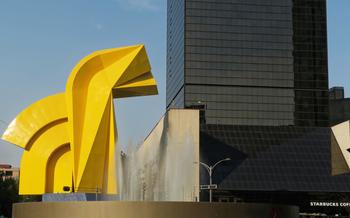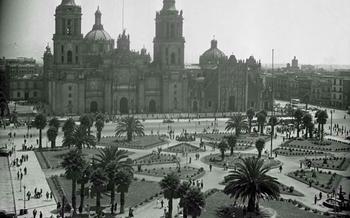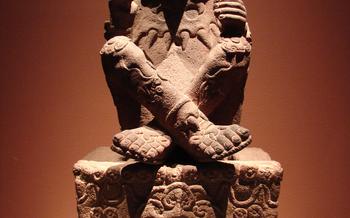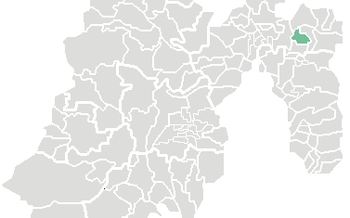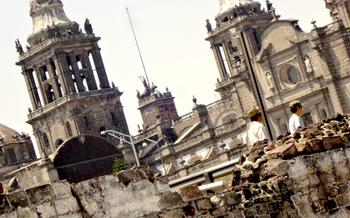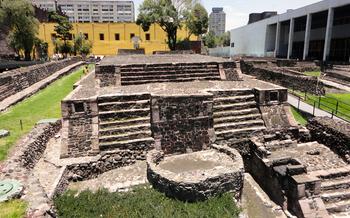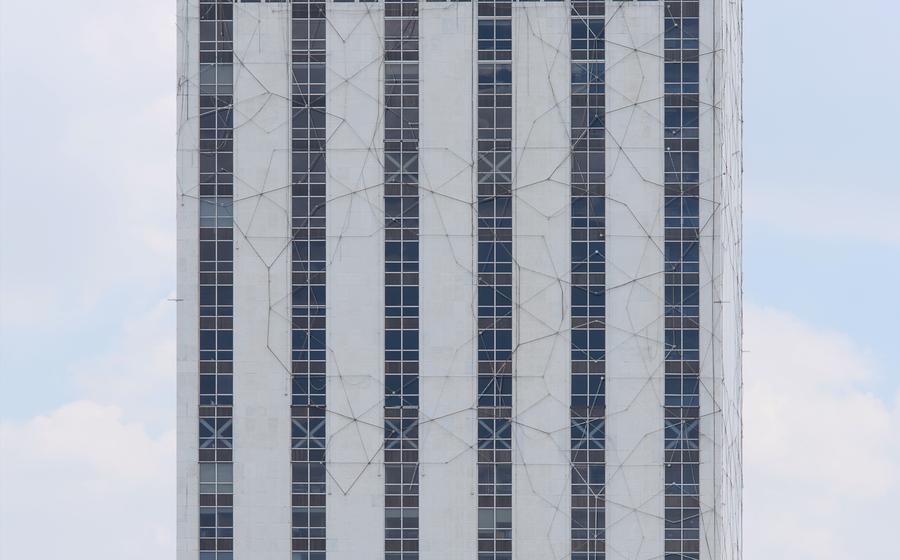
Centro Cultural Universitario Tlatelolco
- Museum of the Tlatelolco Massacre:
- Library José Vasconcelos:
- Auditorio Nacional: A Symphony of Performing Arts
- Museo Nacional de la Cultura Popular
- Casa del Estudiante Indígena
- Foro Internacional Cine Tlatelolco: A Haven for Independent Cinema Internacional Cine Tlatelolco stands as a testament to the power of independent cinema. This cultural center is dedicated to promoting and nurturing the art of filmmaking, providing a platform for emerging and established filmmakers to showcase their work and connect with audiences.
- Planetario Luis Enrique Erro: Exploring the Cosmos
- Insider Tip:
Museum of the Tlatelolco Massacre:
The Museum of the Tlatelolco Massacre is a poignant reminder of one of the darkest chapters in Mexican history. Established on the site of the former Plaza de las Tres Culturas, the museum is dedicated to preserving the memory of the tragic events that unfolded on October 2, 1968, when a peaceful student protest was brutally suppressed by government forces, resulting in the deaths of hundreds of unarmed civilians.
Through a collection of historical documents, photographs, and personal testimonies from survivors and witnesses, the museum provides a comprehensive account of the student movement and the subsequent massacre. It highlights the social and political context that led to this tragic event, shedding light on the deep-seated tensions and grievances that had been simmering in Mexican society for years.
The museum's exhibits are a powerful testament to the human cost of violence and repression. They offer a profound and moving insight into the lives and struggles of the young people who fought for a more just and democratic Mexico, paying the ultimate price for their ideals.
Beyond its historical significance, the Museum of the Tlatelolco Massacre serves as a vital space for dialogue and education. It promotes a critical understanding of the past, fostering reconciliation and healing while reminding us of the importance of defending human rights and upholding democratic values.
Library José Vasconcelos:
The Biblioteca José Vasconcelos, designed by Mexican architect Alberto Kalach, is a stunning architectural marvel that houses an extensive collection of books, including rare and valuable editions. Its digital resources provide access to a vast array of information, making it a haven for scholars and bookworms alike. Beyond its impressive collection, the library hosts cultural events, such as book readings, exhibitions, and conferences, offering a vibrant platform for intellectual exchange and cultural enrichment.
Auditorio Nacional: A Symphony of Performing Arts
In the heart of Mexico City, on the western edge of Chapultepec Park, stands the Auditorio Nacional, an architectural marvel and one of the most prestigious performing arts venues in the country. Inaugurated in 1952, the auditorium is renowned for its exceptional acoustics and state-of-the-art facilities, making it a popular destination for concerts, ballets, and theater productions.
The brainchild of renowned Mexican architect Eduardo del Río, the Auditorio Nacional is a testament to mid-century modernism. Its striking design features a curved concrete shell roof, supported by a series of slender columns, creating a sense of lightness and elegance. The auditorium's interior is equally impressive, with a seating capacity of over 10,000, arranged in a horseshoe-shaped configuration that ensures optimal sightlines from every seat.
The Auditorio Nacional has hosted a galaxy of legendary performers throughout its history, from Mexican icons like Juan Gabriel and José José to international stars such as Frank Sinatra, The Beatles, and Luciano Pavarotti. It has also been the stage for countless ballet and dance performances, as well as prestigious theater productions.
Beyond its role as a performance venue, the Auditorio Nacional is also a cultural hub that actively promotes Mexican culture and showcases international talent. It regularly hosts festivals, exhibitions, and educational programs, providing a platform for emerging artists and fostering a vibrant cultural scene in Mexico City.
Museo Nacional de la Cultura Popular
The Museo Nacional de la Cultura Popular (National Museum of Popular Culture) is a vibrant and engaging institution dedicated to preserving and showcasing the rich tapestry of Mexican popular culture and traditions. Step into this museum, and you'll be immersed in a world of vibrant colors, lively music, and captivating displays that celebrate the diverse expressions of Mexican identity.
The museum's exhibits take you on a journey through the various regions of Mexico, showcasing the unique customs, crafts, and traditions that define each one. Explore the intricate and colorful costumes of traditional dances, marvel at the artistry of handmade crafts, and learn about the fascinating rituals and festivals that bring communities together.
Interactive displays and workshops invite you to engage with Mexican traditions firsthand. Participate in a traditional dance class, learn to play a traditional instrument, or try your hand at creating your own crafts. These hands-on experiences provide a deeper understanding of the skills and techniques that have been passed down through generations.
Through its exhibitions and programs, the Museo Nacional de la Cultura Popular plays a vital role in preserving and promoting Mexico's rich cultural heritage. It's a place where visitors can gain a deeper appreciation for the diverse traditions that make Mexico such a vibrant and captivating country.
Casa del Estudiante Indígena
The Casa del Estudiante Indígena, located within the Centro Cultural Universitario Tlatelolco, is a unique and inspiring initiative that provides educational opportunities and support for indigenous students from rural communities across Mexico. Established in 1982, the complex offers housing, scholarships, and academic support services to help indigenous students integrate into urban life and pursue higher education.
The Casa del Estudiante Indígena recognizes the challenges faced by indigenous students in accessing quality education and aims to create a supportive environment where they can thrive. The complex provides a sense of community and belonging for students from diverse indigenous backgrounds, fostering cultural exchange and mutual understanding.
The Casa del Estudiante Indígena also hosts cultural programs and activities that promote indigenous languages, traditions, and cultural identity. These programs include workshops on traditional crafts, dance, and music, as well as language classes and cultural events that celebrate the richness and diversity of indigenous cultures in Mexico.
Through its educational and cultural initiatives, the Casa del Estudiante Indígena plays a vital role in empowering indigenous students and promoting social inclusion. It is a testament to the university's commitment to diversity, equity, and the preservation of Mexico's rich cultural heritage.
Foro Internacional Cine Tlatelolco: A Haven for Independent Cinema Internacional Cine Tlatelolco stands as a testament to the power of independent cinema. This cultural center is dedicated to promoting and nurturing the art of filmmaking, providing a platform for emerging and established filmmakers to showcase their work and connect with audiences.
The Foro Internacional Cine Tlatelolco boasts state-of-the-art screening rooms, equipped with high-quality projection systems and immersive sound technology. These intimate spaces offer a cinematic experience that rivals that of commercial theaters, allowing viewers to fully immerse themselves in the stories unfolding on the screen.
The center's programming is diverse and eclectic, encompassing a wide range of genres, styles, and perspectives. From Mexican and international feature films to documentaries, short films, and experimental works, the Foro Internacional Cine Tlatelolco showcases the best of independent cinema from around the world.
In addition to screenings, the center also hosts workshops, seminars, and film festivals throughout the year. These events provide opportunities for filmmakers, students, and enthusiasts to come together, share knowledge, and engage in discussions about the art and craft of filmmaking.
Whether you're a seasoned cinephile or simply looking for a unique cultural experience, the Foro Internacional Cine Tlatelolco is a must-visit destination. Immerse yourself in the world of independent cinema, discover new voices and perspectives, and become part of a vibrant community of film lovers.
Planetario Luis Enrique Erro: Exploring the Cosmos
Journey into the depths's most captivating cultural attractions. Step inside this state-of-the-art planetarium and be transported to a realm of celestial wonders, where the mysteries of space and astronomy unfold before your eyes.
Immerse yourself in awe-inspiring shows and presentations that showcase the vastness of our cosmos. Marvel at the beauty of distant galaxies, witness the birth and death of stars, and learn about the latest discoveries in space exploration. The planetarium's domed projection screen and advanced sound system create a truly immersive experience, transporting you to the far corners of the universe without ever leaving Mexico City.
Whether you're a seasoned astronomy enthusiast or simply curious about the wonders of the night sky, the Planetario Luis Enrique Erro offers an unforgettable journey through the cosmos. Engage with interactive exhibits, participate in educational workshops, and let the wonders of the universe ignite your imagination.
Insider Tip:
To make the most of your visit to the Centro Cultural Universitario Tlatelolco, consider planning your trip for a Sunday, when admission is free for all visitors. This allows you to explore the various museums, galleries, and cultural spaces without any financial constraints. Additionally, take advantage of the guided tours offered by the cultural center, which provide a wealth of historical and cultural insights into the site. Combine your visit with a stroll through the neighboring Plaza de las Tres Culturas and the fascinating Templo Mayor archaeological site to gain a comprehensive understanding of the area's rich history. These adjacent attractions offer a unique glimpse into Mexico's pre-Columbian, colonial, and modern past, making for a well-rounded cultural experience.

